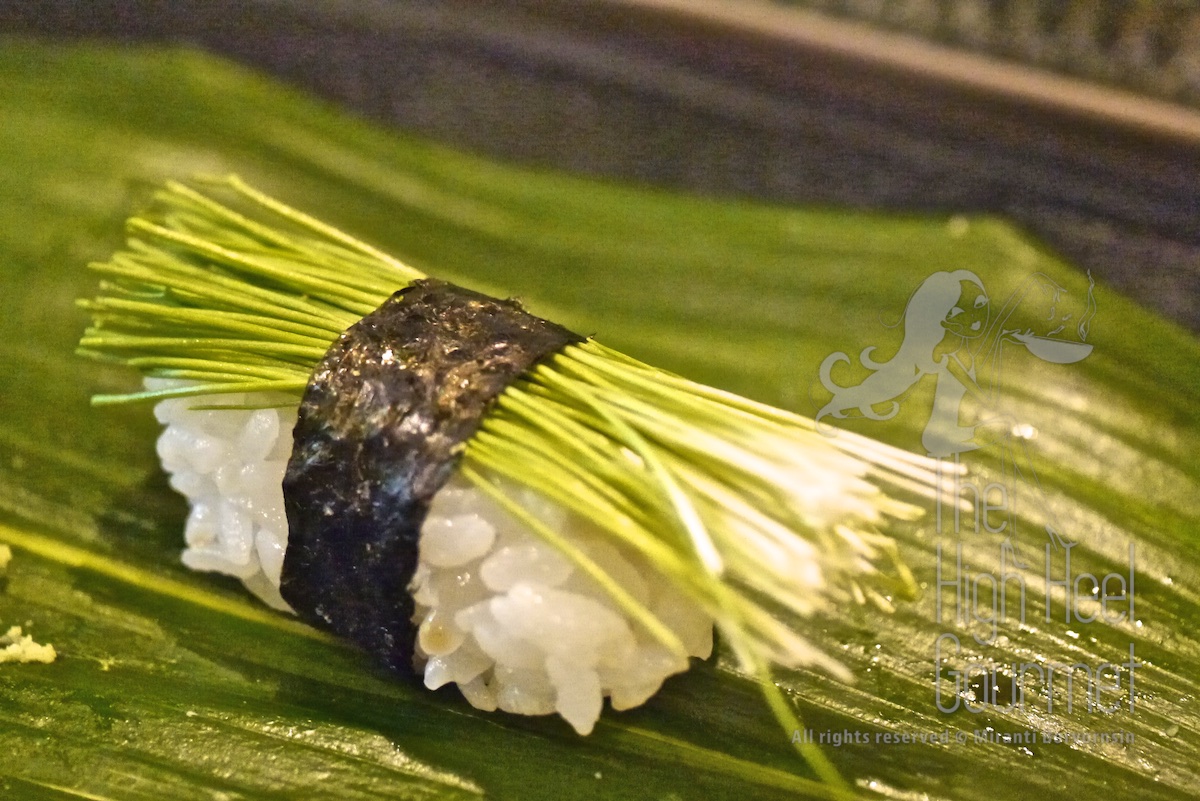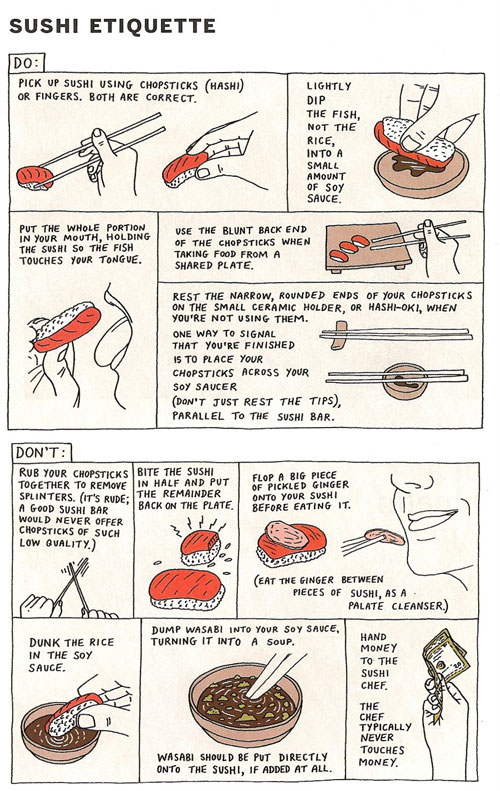Before I post more about my sushi experience in Tokyo, let’s explore the “etiquette” here for a moment. I’m not going to tell you to follow this “sushi etiquette” for cultural reasons–these are ways to enhance the sushi eating experience. If you already love to eat sushi, you might not believe that there is a way to make sushi taste better. However, believe it or not I think you should try this at least once, just to make sure that you’re not missing anything.
The sushi in discussion is edomae nigiri sushi (the one bite of rice in an oblong shape with a piece of fish on top) and gunkanmaki (the one bite of rice wrapped with a piece of seaweed and the top filled with seafood).
1) Do not put wasabi in the soy sauce (shoyu) but put it on the piece of fish itself or, the even better way, put it on the rice.
2) Dip the fish side of the sushi in to shoyu, if it hasn’t already been brushed on by the sushi chef. Do not let the rice touch the shoyu. (Especially do not soak the rice in shoyu like my husband does!)
3) Put the piece of sushi in your mouth with the fish side down so the fish touch your tongue first. Or at the least put it in sideways, so the rice and sushi touch your tongue at the same time. Don’t put it in with rice side down on your tongue.
I would recommend trying this technique at your favorite sushi restaurant. Set out 2 sauce dishes for soy sauce and try both pieces the different ways, the first one with this new way then follow with your own way.
I started eating sushi for the first time in Thailand but I remember that I didn’t like it at all until I ate a cut roll. I think it was called a California roll with mayonnaise, some kind of fish roe, asparagus, cucumber and real crab inside but no avocado. I loved the rolls but I still didn’t like nigiri sushi. I also loved the sashimi. What I ate with these delicated raw goodies was a lot of shoyu mixed with wasabi. Then I went to Japan for the first time. There is no California roll served at any sushi place in Japan. I had nigiri sushi almost everyday but I can’t pick the top off the rice and eat only the raw fish, so I mixed wasabi in shoyu and shamelessly drenched my nigiri sushi with the mixture before I ate.
Then my friend took me to a fancy sushi joint in Ginza. I finally was educated by force. Once the sushi chef saw me pour shoyu in the little saucer before I was served any piece of sushi, he told the waitress to take the shoyu away. He also started to put nigiri sushi in front of us, one piece at a time and he watched. Aiya…I don’t like to eat while being watched! He just stood there waiting for us to put his masterpieces in our mouths. His eyes darted across our faces. It was a power play…mannnnnn! After a long stare-down with his hand gesture he suggested that I should put the piece of sushi in my mouth. I caved in, did what I’ve been told. No, the miracle hadn’t happened yet. It was alright. I was stressing out. It was white fish with slight hint of citrus and no wasabi or soy sauce. How can that be good without a lot of wasabi and shoyu? You know what I’m talking about.
Soon as we put the sushi in our mouth, the chef stopped staring and went back to work. However, as soon as I finished chewing and swallowed, a new piece showed up in front of us of course together with the same pair of eyes that belonged to the same sushi chef. He was worst than any boarding school teacher I ever known. It continued like that for the entire meal. If he wanted us to have shoyu or some other sauces, he would brushed the sauce on top of the fish pieces. He watch us to see how we reacted to the amount of wasabi he put underneath the piece of fish. I believe he adjusted them based on our reaction. We ended up eating several pieces of nigiri sushi. I have to admit that I like a lot of them, the typical stronger flavor fish, the yellowtail (buri), the toro, eel and saba, even though I missed my shoyu mixture. I thought some of them could have been better with my own shoyu mixture. That was my first step.
I was back to Japan for the second time. This time it was properly explained why I should eat sushi this way.
1) The wasabi used in Japan, especially at the fancy sushi restaurants, is fresh grated from the wasabi root. It has its own distinct mustardy flavor that goes up your nose. This flavor would drastically lessen and lose its kick if the wasabi was mixed in anything else, let alone soy sauce.
2) The shoyu at a good sushi place normally was carefully seasoned by the chef. To mix the special shoyu with wasabi would have ruined the work of the chef.
3) The rice is already seasoned and doesn’t need to be re-seasoned by shoyu but the fish does.
4) The ball of rice has air around and in the middle. Yes, it does, so it will explode as soon as you put it in your mouth. Dipping the rice in shoyu would make the ball of rice fall apart.
5) Putting the fish side on your tongue gives the maximum exposure of the fish to the taste buds, then the rice comes in and makes the perfect blend. If the rice lands on the tongue first it would coat the taste buds with starch, preventing the taste buds from tasting the real flavor of fish.
OK…enough of the science. I admit that it took quite a while before I detected the difference in tastes of the different fishes and appreciate the new way (or old way to the Japanese) a lot more. I’ve been eating nigiri sushi this way quite a long time now but I can go back to drench my sushi with mixed shoyu and wasabi if the sushi isn’t good enough, such as not so fresh fish or not so good sushi rice. I converted just in time to sit in front of Jiro Ono, the famous #1 sushi chef in the world, at Sukiyabashi Jiro. This was a while back. I think it was 2004. He also watched me put the piece of sushi he made in my mouth too!
This is the picture I got from the internet about sushi etiquette. Many people have used it. Please let me know if you know who the original owner of the picture is so I can give the proper credit to. The best I’ve found was from
Theworldsbestever.com who said “Thanks Toby” as a by line. I’m not going to thank Toby because I’ve got this picture in my email from a friend who wants to stay anonymous. He got it via bulk forward mail as well.



I am only guilty of mixing my wasabi and soy sauce, too. It’s going to be hard to get rid of!
When I’ve gone out for sushi with some of my family members, I cringe when I see them take just bites of the sushi. What about in the case of maki-sushi? I feel like chefs are making maki sushi so big that no one can really eat it in one bite!
Maki sushi is a little tricky. For Gunkan maki, the oval shape with topping on top, you suppose to use a piece of ginger dip in soy sauce and then brush it on the topping part of the maki and not dipping the piece in the shoyu because then the rice will absorb the shoyu and the seaweed will be even more soggier. The cut roll and hand roll you suppose to eat it just like that. I know…don’t cringe yet…lol. I’m talking about a “good” sushi, you know. The one that they made perfect rice with all the flavor the rice should be and also with great topping. I wouldn’t do this to the average sushi too…ewwwwww.
Mixing wasabi with soy sauce is really a hard habit to get rid off, especially outside Japan when the wasabi comes from green powder mix with water. You don’t get good enough wasabi to know the different. Also standard Kikkoman isn’t the best soy sauce either (The kikkoman that made for sushi is the opposite though). In the US, I only use the etiquette with places that served good sushi rice too. A bite of sushi is such a magical bite in my mind but if it is the not so good one, I put my own magic on it…haha.
In Los Angeles there is a lot of nazi sushi chef, the one that would say to you when he serves you a piece “no soy sauce, please”. I would be able to gauge the rice after I eat the first piece. If he didn’t put enough wasabi, then I can tell him to adjust the amount for me but not with the rice. So, if the second piece is still not good, I would tell the chef to stop serving me, pay and leave. It’s not worth it to continue and also not worth it to try to sneak soy sauce in and got kick out just like someone who doesn’t know the etiquette. I let the chef knows that his food isn’t up to my standard by left in the middle of the meal. It’s the “saying negative thing without really saying a word”.
Almost everyone in HK eats sushi at sushi kaiten (revolving) restaurants, and so it’s more casual…sadly they all mix the “wasabi” paste (i.e. horseradish and mustard) thoroughly with the soy sauce. Also, I often feel I’m the only one using ginger. More education needed…
Everyone in Japan takes their job really seriously haha, and in a way it’s flattering to have the chef pay so much attention to you to make sure you enjoy it the way they intended eh.
I think Chinese and Thai are use to foods that has stronger taste so to eat sushi without a lot of soy sauce or wasabi seems plain. It took me a while to finally identify the different mild taste of the different fishes. Once I can identify them, then the sushi rice (the good one) enhance the taste of the fishes. That’s why I encourage people to at least try. If you can that’s good but if you can’t and the way to enjoy sushi is the use a lot of soy sauce and wasabi, then that’s your style. I don’t think anything wrong with that too.
When I was in HongKong the sushi restaurant that has the longest line was the revolving sushi. This is in Tsim Sha Tsui just across the street from Park Hotel. I hasn’t had a chance to eat there yet. The line was long from the opening until night. I though, ok I would be back by 11pm and there shouldn’t be a line…No, not really. I don’t know the name of the place but I’m sure you know of it or may be you probably already been there.
Very helpful tips!
Hi,
I enjoy your blog, and so I have nominated you for the Versatile Blogger Award.
You can read about what you need to do here: http://londonerfromafar.wordpress.com/2012/05/14/versatile-thanks/
and get a copy of the Award picture (http://versatilebloggeraward.wordpress.com/blog-button/) to place on your blog.
Congratulations!!!
A Londonder from Afar
Please note, the award is completely optional and you do not have to accept.
Just very belatedly posted about this on my blog, with a ref to you. 🙂
Thanks 🙂